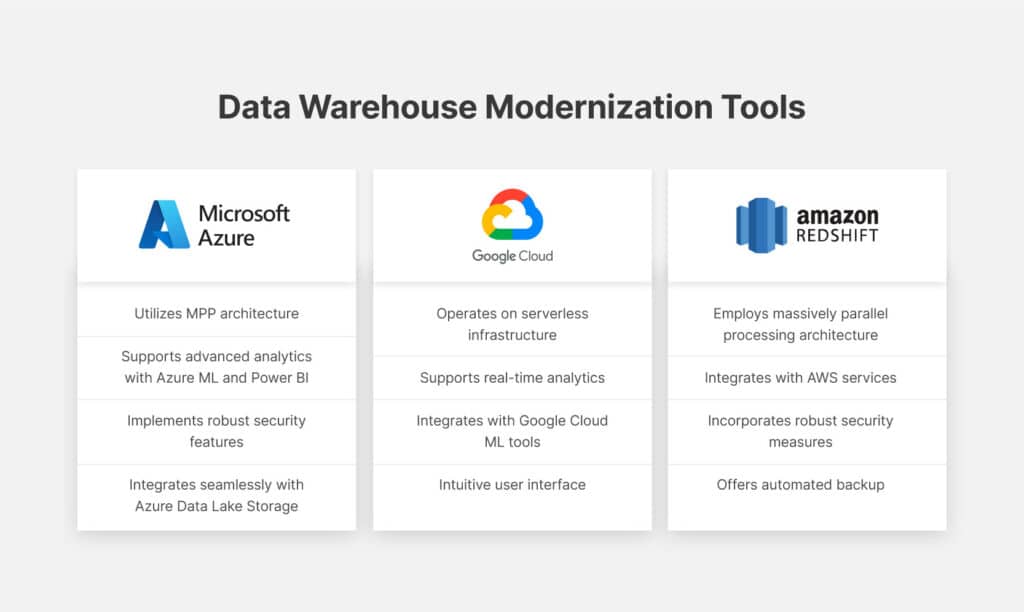
Data & AI Evangelist

Principal Data Architect
Subscribe to the newsletter
Organizations today grapple with an ever-expanding volume of data, requiring more robust solutions than traditional data warehouses can offer. Expanding data volume, processing workloads, and data analysis necessitate additional resources and skilled people. Relying on legacy tools to leverage enterprise data makes it almost impossible to achieve optimal business efficiency and agility in the face of this data surge.
To address this arising concern, organizations are turning to data warehouse modernization as a solution to handle the tons of data and keep pace with modern data demands. This explains why the market size of cloud data warehousing has exceeded a whopping $10 billion and is projected to reach a valuation of approximately $472.47 billion by 2030.
This blog serves as a guide to data warehouse modernization, its pressing need in the present times, its benefits, and a step-by-step guide to embark on modernizing your data warehouse.
What is data warehouse modernization?
Data warehouse modernization is a process of updating and revamping the existing data warehouse infrastructure to better address data management challenges.
As businesses now rely on valuable insights in real-time, legacy data warehouses lack the efficiency to keep up with modern data demands. In such instances, data warehouse modernization emerges as a strategic approach to extract actionable insights from diverse data sources.
Whether it’s structured, unstructured, or semi-structured data, every department- across the organization is leveraging cloud data warehouse modernization to enhance efficiency and stay competitive in the age of big data and AI.
Understanding the need for data warehouse modernization
Although modern businesses rely on voluminous data to make strategic decisions, some businesses still opt for traditional data warehouses for analytical and reporting purposes.
Organizations need to understand that embracing traditional data warehouse solutions comes with its own set of challenges that significantly impact business intelligence outcomes. The more complex the data and business, the more complex the challenges.
The most common challenges with traditional data warehouses include (TDW):
Maintenance cost
The infrastructure of a traditional data warehouse is quite expensive to maintain. It’s not just about fixing issues, it’s about regular updates that add up over time. The rigid structure of a traditional data warehouse makes the modifications time-consuming and ultimately fails to meet real-time data requirements.
Rigid architecture
Traditional data warehouses are rigid and resistant to adaptation. Since bringing changes seems impossible, scalability and agility take a lot of work to achieve. As the data requirements grow, the rigid nature of traditional data warehouses faces challenges to keep up with the fast changes required, making it challenging for businesses to handle large amounts of data.
High failure rates
One of TDW’s major drawbacks is its high failure rate. Gartner once predicted that 50% of data warehouse projects are subject to failure because of a lack of attention to data quality issues, rigid and complex architecture, and its vulnerability to issues such as hardware failures, etc. This vulnerability potentially impacts business continuity and decision-making processes.
Data quality concerns
Another major concern regarding traditional data warehouses is maintaining data quality. When data is extracted from multiple sources and loaded into a data warehouse, discrepancies and data errors occur frequently, leading to false decision-making.
This data integration from various sources results in conflicting decisions, which cause organizations to lose their competitive edge in the business market.
Benefits of data warehouse modernization
Data warehouse modernization offers a myriad of benefits, ranging from improved performance and scalability to advanced analytics capabilities and enhanced security measures. Let’s explore some of them:
- Optimize query response times and improve overall system efficiency, resulting in enhanced performance.
- Consolidate data from various sources for a unified perspective, facilitating comprehensive analytics and reporting while breaking down silos.
- Support real-time data processing, enabling informed decision-making based on the most up-to-date information.
- Incorporate advanced security features to protect sensitive information and ensure data integrity.
- Allow flexibility in choosing cloud providers and support hybrid deployment models for varied infrastructure needs.
Getting started with data warehouse modernization
Data warehouse modernization is more than just a one-step approach. It is a comprehensive process that includes well-defined steps, each contributing to achieving efficiency in data management.
Let’s get into this step-by-step approach:
Step 1: Assess your current stage
Before modernizing the data warehouse, thoroughly assess your existing data warehouse infrastructure. This assessment helps businesses identify the strengths, weaknesses, and areas for improvement.
Also, determine the kind of data volumes, how well the data warehouse performs, and understand the user requirements. This initial step sets the stage for informed decision-making throughout the process.
Step 2: Define business objectives and goals
Before beginning data warehouse modernization, know the business objectives and goals to achieve. These objectives guide businesses throughout the modernization process. Defining objectives for modernizing data warehouses will promote subsequent decisions and ensure alignment with business priorities.
Step 3: Opt for cloud technology
Consider migrating your data warehouse to a cloud-based environment. Opt for a Cloud solution that offers scalability, flexibility, and cost-effectiveness. Azure, Amazon Redshift, and Google Cloud are the big names that provide robust services for modern data warehousing.

Regardless of your choice for a data warehouse modernization solution, make sure to evaluate the features and benefits of each cloud platform to determine the ideal fit for your organization.
Step 4: Implement advanced analytics and Machine Learning
Regardless of your data source, such as social media, log files, or other non-traditional datasets, implement advanced analytics and machine learning capabilities within the data warehouse. This integration allows your business to generate predictive insights and automate decision-making.
Step 5: Plan for data migration
Create a solid data migration strategy to transition your data from a legacy warehouse to a modernized data warehouse environment. A comprehensive data migration plan will ensure a seamless transition while minimizing disruptions to operations.
Carefully map out the migration process, validate data integrity, and conduct thorough testing to ensure a seamless and successful data transition to a cloud-based environment.
Step 6: Monitor and optimize
The data warehouse modernization journey doesn’t end here. It also includes continuous refinement to meet and exceed expectations.
Choose robust monitoring tools to track the performance of your modernized data warehouse and implement a continuous performance assessment strategy for a successful migration. Also, regularly optimize the system to adapt to changing business requirements and data landscapes.
Bottom line
There’s no denying that legacy systems are no longer expected to generate a profitable return on investment (ROI). The current business landscape demands a shift toward modernization, and moving to data warehouse modernization cloud solutions is the first step toward digital transformation. Embracing this advanced technology will position businesses to extract greater value from their data assets.
Remember! Regardless of the business size, the results are only expected if your business diligently adheres to the strategic steps of data warehouse modernization. At Confiz, we help you solve your analytics needs and scale your business through data warehouse modernization services. Our experts streamline your migration path and set you up for the modernization journey without exhausting your IT budget. Reach out to us at marketing@confiz.com today to discuss your requirements.



